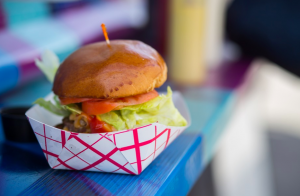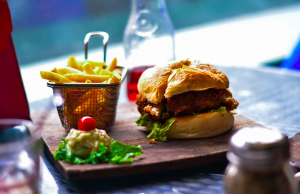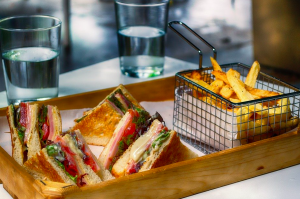Before people taste your food, they see it with their eyes. They smell it. Here’s some tips you can use to improve the appearance of your food to encourage more people to give your truck, trailer, or food stall a shot.
Retailers are more likely to carry your product if they know they can move it quickly off the shelves. Shelf space is always at a premium and no retailer wants to carry a line that will simply sit and sit and sit.
When you’re selling-in to a retailer or vending at an event, you need to build confidence that:
- You’ll support the product with creative and widespread marketing (driving NEW customers into their stores)
- You’ll be available at the store to direct consumers to your product and move it quickly off the shelf, increasing their sales and encouraging repeat business
Demos are time- and labor-intensive. Think of yourself as a performer going out on tour. You need to be prepared for days, weeks, and even months of smiling, meeting and greeting, travel, and exhaustion. Unlike trade shows or consumer events where you spend one to three days selling your product, demos require multiple sessions at multiple stores.

An impressive display of cupcakes.
Here are some tips for ensuring your food demos are effective:
Planning for your demo
- Develop a budget for demos. Although you may need to start small (one person with a table and a cooler and some coupons), the more attractive and obvious your demo, the greater the traffic. Calculate how many sales you’ll need to make the cover the demo costs. Your first demos may lose money, but they are essential to building traction over time.
- Use a calendar tool (preferably one that’s Cloud-based, so you can share it with others) to keep track of all upcoming demos.
- Resist the urge to over-book, unless you have a trained team to handle demos (see People, below).
- Speak directly to the store and/or department manager as often as possible before the demo date(s). Find out how much space you’ll have, where you’ll be located, and how much product they’ll be ordering.
- If budget permits, consider creating a fun “demo station.” We built a very portable and compact structure for one of our food clients, as well as a cardboard “mascot.” Customers liked taking pictures at the demo station, which helped the brand spread virally (see Marketing, below).
- Create a great offer for the demo – discount coupon, free gift with purchase, or other incentive for trial. You may also consider making a donation to a local charity for the sales you make that day.
- Make sure your demo station is located near the shelf where your product is being sold. If the retailer permits, add signage to the shelf, pointing shoppers to your demo station. We once did a demo at the front of the store, but the product was in the refrigerator section at the back. This presented some logistical challenges. We drew “maps” so customers could easily find their way and said things like “Go to the butter, and then look left.”
- Get to your location early and be prepared to stay late (if the store allows). Making a good first impression at the retail level will ensure you get invited back.
- If other demos are going on at the store at the same time, “make friends” with the other people and offer to direct traffic to their station. Like at trade shows, exhibitors can create their own “communities” and join forces to co-market and support each other.
The People at Your Demo

If you can’t stand the heat, cool down the kitchen!
- At first, you’ll probably be doing many of the demos solo. That’s not a bad thing. You know the most about your product(s) and can be more passionate about it than anyone else. But, as you scale your business, you’ll need to be spending more time on the business side of the desk, managing financials and manufacturing, and setting a vision for growth. Start looking for trusted team members early on. Family and friends can be helpful but only if they have the right personality for sales. Introverts and sad sacks can do more harm than good. People want to sample food offered by people who are charming and credible.
- Interview and recruit the right “demo squad.” Allow time for training these people to talk about your product in an informed and enthusiastic way. Anyone can scoop or sample; true brand ambassadors can engage, dazzle, and sell. Make sure your ambassadors love your product. (A vegetarian trying to sell a meat-based product is probably not the right match.) Local colleges (marketing/communications majors) and acting schools can be a great source of temporary help. Once you are making real money, engage a professional marketing/PR company or company that specializes in recruiting product demonstrators.
- Train, train, and then train some more! Make sure the people who are working your station know exactly what they are supposed to do.
- This may sound silly, but print up a “Be Back in 5 Minutes” sign, so that when your demo person needs to take a hygiene or snack break, customers will know to return.
- Demo people should ask the customer questions like “What’s your favorite flavor?” “How can we improve the product?” “What brand do you currently eat/drink and why?” Do NOT get defensive if you get negative feedback. Smile and nod and thank customers for their honesty.
- Remember, you want people to not only love your product but to remember the people behind it. Whoever staffs your demo is a reflection on your brand and your company.
Marketing Your Demo

Although some retailers will advertise the companies that will be demo-ing products in their stores, many do not. Be willing and able to take on this responsibility. Here are some ideas:
- List your demo schedule on your website and in your social media outlets; include in your e-newsletter, if you have one.
- Research local event listing calendars near the store. Many of this media outlets will allow you to post your own events. Remember, you’re a “performer” for the day. Treat the demo as you would a concert or event and make sure to build excitement for it.
- Take pictures throughout the day and post them on your social media sites. Live tweet the event and post regularly on Facebook, to reach people who may be prompted to go to the store if they see how much fun they’re missing. Be sure to tag the name of the store too.
- Invite local media and bloggers to come to the demo and offer them free samples.
- If you have a fun “activity” at your demo (photos with a mascot, temporary tats, or any other wacky thing you dream up), encourage customers to post their photos on social media sites and tag your product brand AND the name of the store.
- Run a drawing and use it to capture e-mail addresses.
- Encourage customers to provide feedback on your product. Capturing e-mails will enable you to conduct simple post-demo surveys. The information can be used for product improvement and new product lines.
What to do After Your Demo

This meal could come from five or more suppliers… Or only one.
- Before you leave, check the store inventory and tally up sales.
- Reflect on what went well and what you’ll do differently next time. Ask for feedback from the retailer too.
- Do not get discouraged by a demo that doesn’t go well. If you’re striking out on multiple occasions, you’ll need to re-evaluate your strategy.
- Thank the store managers immediately. Send a personal note of gratitude too. (People still love getting snail mail!)
- Post your pictures on social media and thank all the customers who sampled/bought. Let them know where you’ll be heading next.
- If you had media attend your demo, be sure to thank them for covering the event and post any press mentions on your website.
Demos can be hard and time-consuming work, but they pay off in the long run. But be sure you’re allocating the time for them, staffing them with the right team, and fully leveraging their marketing/sales potential. After all, getting consumers to taste your product is the best way to get it off the shelves and into their homes.
If they love it, they will return and tell their friends and family. And that’s ultimately what food marketing is all about – word of mouth and word of stomach!

Leave A Comment